Comparative and Superlative AdjectivesComparatives and superlatives are adjective forms that are utilized for comparing two or more objects. 
The most difficult aspect of utilizing comparatives and superlatives is ensuring that we write them correctly, but comparatives and superlatives may be rapidly mastered with a little practice. In this post, we'll go over what comparatives and superlatives are, how to compose them correctly, and how to utilize them effectively in a statement. What Are Comparative Adjectives?Comparative Adjectives are adjectives that describe one noun by comparing it to the other noun. We normally think of 'er' terms as larger or smaller, but they can be somewhat more challenging. The frequency of syllables in the adjective or whether or not the adjective finishes with the letter 'y' influence how we build comparative adjectives. 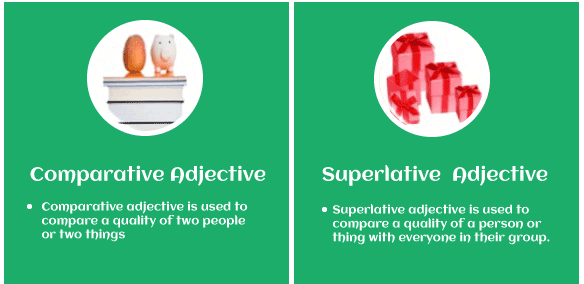
What Is a Superlative Adjective?Superlative Adjectives are terms that characterize a noun in the greatest or lowest degree when compared to two or more nouns. Consider the following phrases: tall, taller, tallest, or hot, hotter, hottest. It's not always as easy and simple as attaching 'est' to comparison adjectives. The number of syllables and whether the adjective finishes with the alphabet 'y' also play a role in determining how to build a superlative adjective. 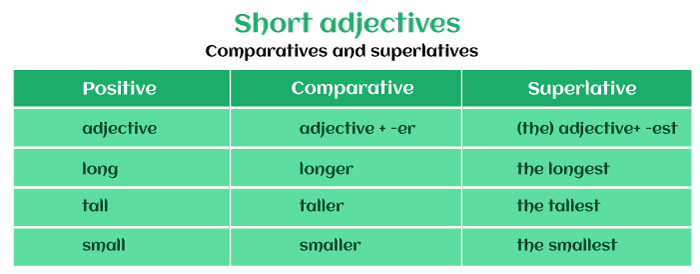
Adjectives with a single syllableLet us have a look at the table below that shows the comparative and superlative types of the words. This table shows the forms for the most classic one-syllable adjectives, in which we attach 'er' for the comparative form and attach 'est' for the superlative form. Note: Whenever the adjective comes after the CVC or consonant, vowel, then in such cases the consonant spelling, the final consonant will double.
Comparative Adjectives:
Superlative Adjectives:
Take note of the terms that surround the comparative and superlative adjectives. Usually, comparatives are accompanied by the word 'than,' while most superlatives are accompanied by the term 'the.' Adjectives with Two SyllablesLet's take a closer look at a chart that shows the comparative and superlative versions of the term for two-syllable adjectives. Comparative adjectives with two syllables can be made by attaching the terms 'more' or 'less' prior to the adjective or by placing the 'er' at the end. One must use the 'est' ending for the superlatives, but the words 'most' or 'least must be used instead of 'more' or 'less' for superlative adjectives.
In many circumstances, it should be noted that either type of the comparative or superlative can be employed, but there is a 'most popular' usage. Furthermore, as the example in the table illustrates, the adjective must not necessarily have an ending with 'y' to utilize or employ the suffix 'er' or 'est' . Your ears often understand and recognize what sounds right and accurate. Comparative Adjectives:
Superlative Adjectives:
Take note of how comparative adjectives always have the term 'than,' before them and the superlative adjectives have the word 'the' prior to them. 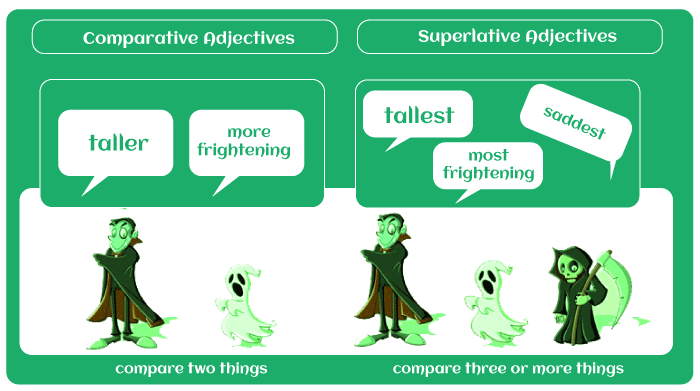
Adjectives with three or more syllablesIn case of adjectives with three or more syllables, the table below illustrates the comparative and superlative variants of the words. We usually add the word 'more' or 'less' in front of a comparative adjective and 'most' or 'least' in front of a superlative adjective in these circumstances.
Adjectives of Comparison:
Superlative Adverbs:
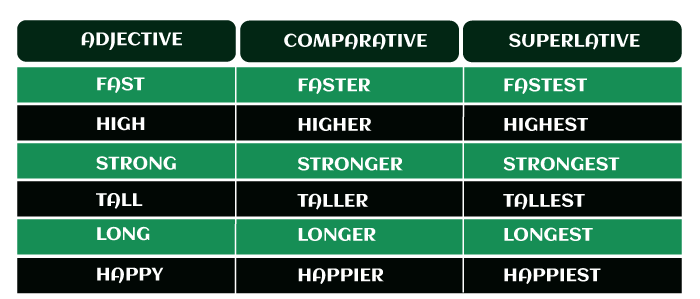
Irregular AdjectivesIt is significant to remember that a few irregular adjectives do not comply with the rules above when employing comparative and superlative adjectives. These irregular adjectives and their comparative and superlative versions are depicted in the table below.
Comparative Adjectives:
Superlative Adjectives:
2 Tips for Identifying and Using Comparative and Superlative AdjectivesTip 1: Rearrange your sentences to use different adjective forms.If we alter our statement to accommodate the adjective, we might utilize different forms of the adjective. Here are some of the instances of one-syllable adjectives: Comparative Example: I moved faster than my classmate. Let's restructure the sentence so that we can utilize the superlative form of the adjective. Between my classmate and, I moved the fastest. The comparison is still being done amongst the two individuals in this case, but because the nouns being compared are limited, we can utilise the superlative form of the adjectives. Take note that this sentence follows the other superlative feature of employing the word "the" just before the adjective. Superlative Example: That's the shortest video in the sequence. Let's restructure the sentence so that one can utilize the comparative form of the adjectives. That one was shorter than any other video in the sequence. The comparison to two or more videos is still being made here, and we are still defining it to the most basic level. We can utilise the comparative type of the adjectives by putting 'any other' before 'video in the sequence.' This sentence now incorporates the other comparative feature of utilizing the term 'than' following the adjective. Tip #2: Consider your spelling guidelines before using the comparative or superlative variant of an adjective.When we modify the ending of a word, we must consider how the word is commonly spelled. If the adjective already has an 'e' at the ending, only try adding 'r' for the comparative and 'st' for the superlative.
Whenever the adjective ends in a consonant + short vowel + consonant (CVC), we usually double the last consonant.
If an adjective concludes in a 'y,' we transform the 'y' into an 'i.'
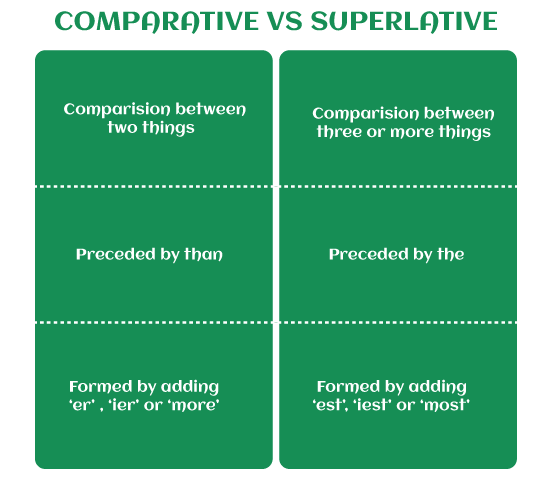
When should comparative and superlative adjectives be used?As previously stated, we employ comparative adjectives to compare two persons or items, and superlative adjectives are used for comparison of more than two people or things:
A superlative adjective is used when something or someone is being compared with every other participant in their group:
When using plural nouns or words/phrases that allude to a group as a single entity, you must exercise caution. Even when a word refers to several persons or items, we employ a comparative adjective when comparing two unique items, groupings, or divisions. As an example: I believe that strawberries are tastier than cherries. (The words strawberries and cherries relate to different types of fruit in this phrase. We use a comparative adjective since we are still comparing exactly two items.) America has a larger land area than several European countries. (In this line, the word "several European countries" refers to a single group. Even though America is being compared to numerous countries, we are only comparing two separate things grammatically. Therefore, we employ a comparative adjective.) One must always be on the search for statements that contain conjunctions. Conjunctions are frequently used to connect numerous comparisons. Even in this scenario, we frequently employ comparative conjunction. As an example, Christine is shorter than Bobby, Canica, and Heena. Why do we use a comparative adjective in the preceding sentence when we plainly refer to more than 2 persons? Take a moment to reread the statement and pay proper attention to what it is saying. This statement uses the conjunction to connect three distinct comparisons: instead of comparing the four persons to one another, we are contrasting Jessica to one and other individual three times. If we intended to use a superlative adjective alternatively, we could restate the statement without conjunction, comparing all four people: Christine is the shortest member of her group of pals, which also includes Bobby, Canica, and Heena. Finally, keep in mind that comparative and superlative adjectives may be employed interchangeably in idiomatic formulations. Have a glance at the below -mentioned two sentences:
Do they sound correct to you? Probably! However, linguistically, the first is regarded as a nonstandard use since there can't be several "biggest animals." A group of animals is either the biggest, or it isn't. However, statements comparable to the first example are likely to be employed in both writing and speech. It conveys the same sense as the second sentence, but it emphasizes the size and mass of a hippopotamus more than the second statement does. Review and Practice Comparative and Superlative AdjectivesNow since you understand what comparative adjective and superlative adjective are and how to position them appropriately in a sentence, try identifying them and exploring for the appropriate use. Remember that comparative adjectives describe a noun by making a comparison to another noun. Superlative adjectives characterize a noun, and provide comparison to two or more other nouns to the greatest or least degree.
Next TopicOrder Of Adjectives
|
 For Videos Join Our Youtube Channel: Join Now
For Videos Join Our Youtube Channel: Join Now
Feedback
- Send your Feedback to [email protected]
Help Others, Please Share










